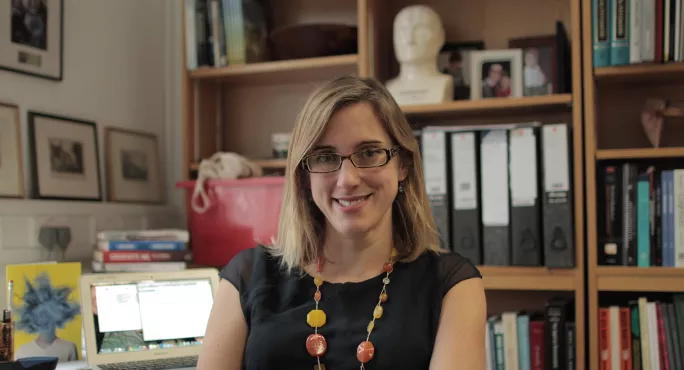- Home
- TES talks to...Sarah-Jayne Blakemore
TES talks to...Sarah-Jayne Blakemore

If you are of the opinion that a school entrance exam provides an accurate measure of a child’s innate intellectual ability, you might want to reconsider your stance fairly quickly. It is, according to cognitive neuroscientist Sarah-Jayne Blakemore, completely wrong.
Blakemore, who is a professor of cognitive neuroscience at University College London, was part of a team that conducted a large-scale study into whether the kinds of cognitive skills that are measured by IQ tests and school entrance exams, which are often thought to be “fixed” abilities, could in fact be trained. What she found agreed with other research suggesting that they can.
“It is possible to get a lot better at non-verbal reasoning if you practise it for 10 minutes a day for a month,” Blakemore says. “This is very interesting because it questions the idea that this is a fixed ability that can tell you something about a child’s innate ability. Absolutely not. There is no evidence for that whatsoever.
“The funny thing is that everyone I work with in my field would say, ‘Of course it’s not. Nothing is fixed. The brain is plastic. You can always train.’ But it comes as a surprise to people who, say, set grammar school entrance exams.”
The study also revealed that late adolescents (between the ages of 15.9 and 18 years) learn at the same rate as mid or early adolescents, challenging the long-standing assumption that we learn more effectively when we are younger. What’s more, the results indicate that it might actually be easier to learn certain high-level cognitive skills, including non-verbal reasoning, in late adolescence.
“Perhaps the brain needs to be a bit more developed, or perhaps you need to be a bit better at developing strategies and then you become more efficient at learning it,” Blakemore explains.
Unpicking teenage brains
Challenging received wisdom about how young people learn is all in a day’s work for Blakemore, who is recognised as a leading expert on cognitive development in adolescents. Her 2012 TED talk, “The mysterious workings of the adolescent brain” has been viewed more than 2 million times.
She was also awarded the Klaus J Jacobs Research Prize in 2015 in recognition of her “groundbreaking achievements in child and youth development”.
That’s not bad going for someone who never set out to study adolescents, having based her early research on schizophrenia. It was working with patients in psychiatric hospitals that first led Blakemore to become interested in the teenage brain.
“I studied what was going on in the brains of people with schizophrenia, who were experiencing really devastating psychiatric symptoms, like hearing voices and having very strong delusions that people were trying to kill them,” she says. “I must have tested almost 200 patients altogether and, without a single exception, they all said that they started experiencing these symptoms at some age between 18 and 25.
“That really interested me. I wondered, what is it in the brains of teenagers that goes wrong in those people who go on to develop schizophrenia? What’s going on in the brain at that age? Because something must be changing at that relatively late age.”
‘Personally, I don’t see the point in a national exam at age 16’
While other developmental conditions, such as autism and dyslexia, emerge at an earlier age, schizophrenia develops much later, Blakemore says.
“It was probably about 16 years ago that I became interested in that question,” she recalls. “And back then, not very much was known about adolescent brain development at all - even typically developing adolescents, let alone those who become mentally ill. So at that point I decided to study it.”
Two decades ago, Blakemore’s undergraduate textbooks told her that almost all brain development happened in childhood and that very little changed afterwards. This remained the general consensus, she says, until scientists began using MRI technology to look inside the living human brain and track changes during a person’s lifespan. The first study of this kind was published in the late 1990s and many have followed.
“All of those studies point to substantial and protracted development across almost the entire cortex during childhood - of course, we already knew that - and during adolescence. And this development goes right on into the twenties in many brain regions,” Blakemore says.

The journey to adulthood
One of the latest-developing regions is the prefrontal cortex, an area of the brain that is involved in processes such as decision-making, planning, self-awareness and inhibition. This perhaps helps to explain some of the more typical teenage behaviours, such as acting impulsively and taking risks, which have traditionally been linked to hormonal changes during puberty or big social changes at school.
But while hormonal and social factors do play a role, teachers also need to be aware that teenagers’ brains are undergoing substantial development at the same time. This might lead educators to start making allowances for them from time to time, or cause a shift in expectations.
“My 11-year-old is almost the same height as me,” Blakemore says. “He doesn’t look adult yet, but it won’t be long. In a couple of years, he will physically resemble an adult, but that doesn’t mean his brain is adult. And that’s the key thing.”
Remembering this might not always be easy when you are, for example, a young teacher standing in front of a Year 11 class who already look and talk like adults, and who all need to meet target grades. But Blakemore suggests that our current approach to exams and assessment could be at odds with the timeline for adolescent brain development.
“Personally, I don’t see the point in a national exam at age 16,” she says. “It made sense when young people could leave education at 16, but now they can’t, what’s the point? What a lot of stress at a critical time in life, when it’s no longer really necessary.”
Blakemore adds: “The pressures we put on teenagers to organise their lives, to plan their GCSE projects and all their homework, and get it all done, aren’t really in line with what we know about how their brains are developing.”
Given that mental illness appears to be on the rise among young people, with at least three children in every UK classroom now said to have a mental health condition, might it be time to reassess the pressure we place on teenagers at a time when they are still developing cognitively? This is certainly something that concerns Blakemore, not only as a scientist but also as a mother of two children who are approaching adolescence.
“I do think that mental illness is one of the major problems that we have in this society and it really needs to be tackled,” she says. “It’s not being tackled at all; in fact, quite the opposite. There is lip service paid to it, but nothing is really being done about it.
“We know that mental illness is most likely to start in adolescence…but we don’t really know why.” Like much else to do with the teenage brain, though, this is something that Blakemore is determined to discover: “There’s so much we don’t know, but it’s really critical that we work it out.”
Helen Amass is deputy features editor for TES and a former teacher. She tweets @Helen_Amass
Keep reading for just £1 per month
You've reached your limit of free articles this month. Subscribe for £1 per month for three months and get:
- Unlimited access to all Tes magazine content
- Exclusive subscriber-only stories
- Award-winning email newsletters



